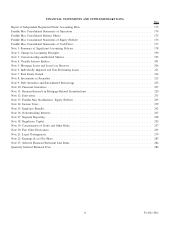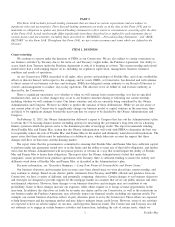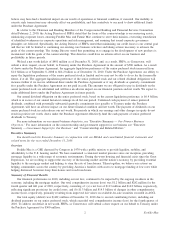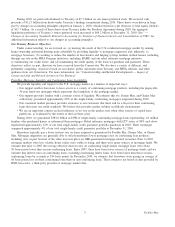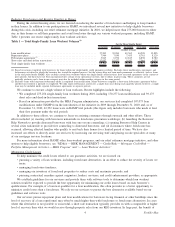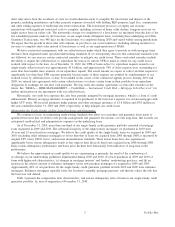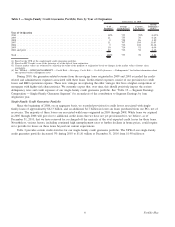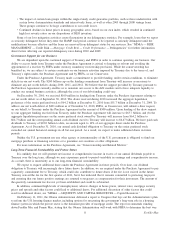Freddie Mac 2010 Annual Report Download - page 13
Download and view the complete annual report
Please find page 13 of the 2010 Freddie Mac annual report below. You can navigate through the pages in the report by either clicking on the pages listed below, or by using the keyword search tool below to find specific information within the annual report.Our Business
We conduct business in the U.S. residential mortgage market and the global securities market under the direction of our
Conservator, FHFA, and under regulatory supervision of FHFA, the SEC, HUD, and Treasury. The size of the
U.S. residential mortgage market is affected by many factors, including changes in interest rates, home ownership rates,
home prices, the supply of housing and lender preferences regarding credit risk and borrower preferences regarding mortgage
debt. The amount of residential mortgage debt available for us to purchase and the mix of available loan products are also
affected by several factors, including the volume of mortgages meeting the requirements of our charter (which is affected by
changes in the conforming loan limit by FHFA), our own preference for credit risk reflected in our purchase standards and
the mortgage purchase and securitization activity of other financial institutions. We conduct our operations solely in the U.S.
and its territories, and do not generate any revenue from or have assets in geographic locations outside of the U.S. and its
territories.
Our charter forms the framework for our business activities, the initiatives we bring to market and the services we
provide to the nation’s residential housing and mortgage industries. Our charter also determines the types of mortgage loans
that we are permitted to purchase. Our statutory mission as defined in our charter is to:
• provide stability in the secondary market for residential mortgages;
• respond appropriately to the private capital market;
• provide ongoing assistance to the secondary market for residential mortgages (including activities relating to
mortgages for low- and moderate-income families, involving a reasonable economic return that may be less than the
return earned on other activities); and
• promote access to mortgage credit throughout the U.S. (including central cities, rural areas, and other underserved
areas).
Our charter does not permit us to originate mortgage loans or lend money directly to consumers in the primary
mortgage market. We provide liquidity, stability and affordability to the U.S. housing market primarily by providing our
credit guarantee for residential mortgages originated by mortgage lenders and investing in mortgage loans and mortgage-
related securities. We use mortgage securitization as an integral part of our activities. Mortgage securitization is a process by
which we purchase mortgage loans that lenders originate, and pool these loans into guaranteed mortgage securities that are
sold in global capital markets, generating proceeds that support future loan origination activity by lenders. The primary
Freddie Mac guaranteed mortgage-related security is the single-class PC. We also aggregate and resecuritize mortgage-related
securities that are issued by us, other GSEs, HFAs, or private (non-agency) entities, and issue other single-class and
multiclass mortgage-related securities to third-party investors. We also enter into other guarantee commitments for
multifamily mortgage loans, certain HFA bonds under the HFA initiative, and housing revenue bonds held by third parties.
Our charter limits our purchases of single-family loans to the conforming loan market. The conforming loan market is
defined by loans originated with UPBs at or below limits determined annually based on changes in FHFA’s housing price
index, a method established and maintained by FHFA for determining the national average single-family home price. Since
2006, the base conforming loan limit for a one-family residence has been set at $417,000 with higher limits in certain “high-
cost” areas. Higher limits also apply to two- to four-family residences. The conforming loan limits are 50% higher for
mortgages secured by properties in Alaska, Guam, Hawaii and the U.S. Virgin Islands.
Our charter generally prohibits us from purchasing first-lien single-family mortgages if the outstanding UPB of the
mortgage at the time of our purchase exceeds 80% of the value of the property securing the mortgage unless we have one of
the following credit protections:
• mortgage insurance from a mortgage insurer that we determine is qualified on the portion of the UPB of the mortgage
that exceeds 80%;
• a seller’s agreement to repurchase or replace any mortgage that has defaulted; or
• retention by the seller of at least a 10% participation interest in the mortgage.
Under our charter, our mortgage purchase operations are confined, so far as practicable, to mortgages which we deem to
be of such quality, type and class as to meet generally the purchase standards of other private institutional mortgage
investors. This is a general marketability standard.
Our charter requirement for credit protection on mortgages with LTV ratios greater than 80% does not apply to
multifamily mortgages or to mortgages that have the benefit of any guarantee, insurance or other obligation by the U.S. or
any of its agencies or instrumentalities (e.g., the FHA, the VA or the USDA Rural Development).
Until June 2011, as part of the MHA Program, we may purchase single-family mortgages that refinance borrowers
whose mortgages we currently own or guarantee without obtaining additional credit enhancement in excess of that already in
10 Freddie Mac


